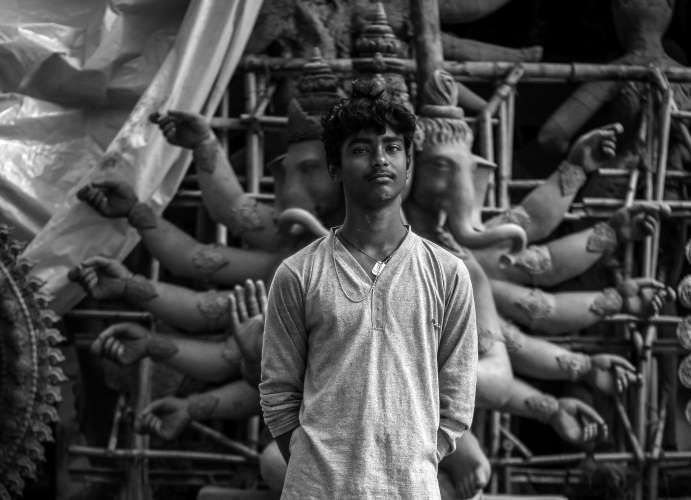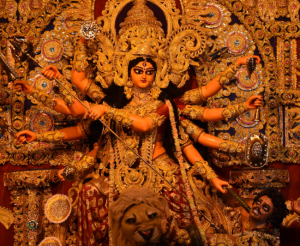
Ignored Durga Puja artisans: Durga Puja in Bengal is a cultural phenomenon that goes beyond mere religious fervour. Durga Puja has left a prominent mark on the global cultural map too. Last year UNESCO conferred an Intangible Heritage tag on puja. It is the first Asian festival to receive the recognition. Apart from the prestige associated with it, the tag will bring international tourists who want to witness the grandeur of the festival.
According to UNESCO, cultural heritage “includes traditions or living expressions inherited from our ancestors and passed on to our descendants, such as oral traditions, performing arts, social practices, rituals, festive events, knowledge and practices concerning nature and the universe or the knowledge and skills to produce traditional crafts”. Intangible cultural heritage is “traditional, contemporary and living at the same time”, inclusive, representative, and community based.

In the last two years, Durga Puja faced enormous challenges because of the Covid-19 pandemic, but still could preserve its socio-cultural continuity. Further, the Puja celebration has a significant impact on the socio-economic conditions. However, The puja artisans and art labourers whose contributions have primarily made Durga Puja what it is today seem to have no share in the overall prosperity. They remain faceless, invisible and without access to any social security.
READ I Missing facts: Labour reforms debate in the context of India’s 4 labour codes
In Bengal, puja is celebrated not only as a religious festival, but it occupies a distinct cultural space too. Over time, it has become a public festival occupying public spaces. Transforming from the family religious ritual of rural Bengal, puja has turned into an urban secular practice exploring multidimensional cultural discourses. In the last two years, Durga puja in Kolkata faced severe challenges because of the pandemic, but it could withstand the challenges and survive through innovation.
In the last two years, some of the puja pandals left remarkable cultural footprints in terms of contemporary relevance and cultural excellence despite curtailed budgets and limited time. Combining traditional and modern ways of depicting art is something not new in the context of Durga Puja in Kolkata. A few artists rose to the occasion and came up with superlative creations in sync with the changing circumstances and challenges therein.
This is an established fact that the puja in Bengal transcends religiosity and becomes a cultural landscape. Such innovation and drawing inspiration from the past and relating that to contemporary relevance makes the puja a distinct cultural event that goes beyond the apparent religious fervour. The UNESCO tag reconfirms this rich cultural heritage.
Last few months, there has been renewed interest in the public domain about the cultural richness and creativity on display on the occasion of the Durga puja. However, there have been few deliberations about the socio-economic conditions of art workers/artisans whose toil and skill make Durga puja what it is.
The invisible Durga Puja artisans
The puja is the most prominent event in the cultural landscape of Kolkata and Bengal. It showcases a lot of creative energy and is an important event in economic terms too. But in spite of such creativity and excellence in cultural pursuit, it is disheartening to note that art labour/workers or artisans remain in poverty and they have no share in the apparent visible prosperity.
Durga puja generates a lot of business and the entire festivity thrives mostly on the creativity displayed in idol-making and pandal-making. There is a constant effort on the part of the organisers to upscale the creative part and because of these theme-based pujas gained enormous popularity in the last two-three decades.
A major part of this popularity is derived from the creative aspects but those who create, remain invisible and economically neglected. We talk about a few artists who provide the design and the concept but thousands of workers who essentially create the visual delight remain unrecognised and unrewarded in an economic sense.
Durga Puja in Bengal is the biggest festival in this state and Kolkata Durga Puja is one of the biggest street festivals in the world. It is also one of the largest employment generators in the state, providing jobs to over 10 million people for nearly six months every year.
As per trade sources, the five-day festival generates transactions worth Rs 4,500 crore in Kolkata and Rs 15,000 crore in the entire state. Of the 4,500 odd community Pujas, 200-odd provide employment to more than 50 people each. The remaining 4,300 odd Pujas employ at least 20 people each. A 2013 Assocham study estimated the size of the Durga Puja industry at ₹25,000 crore with a compounded annual growth rate (CAGR) of about 35%.
A recent British Council study focussed on the 10 creative industries that drive Durga Puja and indicated that a Rs 32,377 crore creative economy was generated during Puja 2019 in West Bengal, accounting for 2.58% of the state GDP. The complete Puja economy, however, may be much beyond that. Corporate funding and outdoor advertising account for about 90% of the funding of the Pujas.
However, within this story, there is another story that remains invisible. Economies of Durga Puja do create substantial jobs during the festival and over the months preceding the festival. However, artisans and art labour remain invisible. The grandeur of Durga Puja is all there to see but the working and living conditions of artisans and art labour is an area which remains hidden in literature and public policy making.
If we take the organization of Durga Puja as a form of production, artisans and labourers remain as mere inputs in the production function like that in other forms of capitalist production structure. In fact, with respect to almost all the labour and artisans involved in Durga Puja as part of the production eco-system, terms of employment and conditions of service are entirely informal in nature.
All are engaged as daily rated workers. Wage is determined through individual bargaining and working conditions are dismal. There is absolutely no formal contract between the labourers and employers. The majority of labourers work under the same employer for a long period of time, however terms of employment remain entirely informal.
The extent of unionisation among artisans and workers is minimal and collective bargaining does not happen. Social dialogue and tripartite consultation are entirely absent. Labourers and artisans lack any form of social security options. The majority of labour laws do not apply in such instances. They don’t have access to institutional social security. At best, they are registered as unorganised workers and might receive certain benefits under the existing social security schemes. But, social security in the true sense, eludes them.
The discourse from the Durga Puja artisans’ perspective is an area which is entirely missing in the existing literature and policy discourse. Since we are celebrating the recent UNESCO recognition and there is a renewal of interest in the cultural richness of Durga puja, it is time we talk about the conditions of art workers associated with it.
Undeniably, art workers play an important role in making Durga puja a grand spectacle and economic investments that are made. This should be recognised both in cultural and economic terms. Art workers should get their shares in economic terms and they should have access to institutional social security.
(Dr. Kingshuk Sarkar is an Associate Professor at the Goa Institute of Management, Goa. Geeti Karmakar is an Assistant Professor at the National Institute of Fashion Technology, Jodhpur. Views expressed belong to the authors and not necessarily that of the organizations they belong to.)
Dr Kingshuk Sarkar is an associate professor at the Goa Institute of Management. He has worked as a labour administrator with the government of West Bengal. He earlier served as a faculty member at VV Giri National Labour Institute, Noida and NIRD, Hyderabad. Views expressed are personal.

